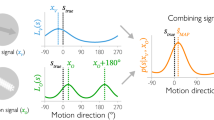Abstract
Is human motion perception based on a local piecemeal analysis of the image or do global effects play an important role? We used metastable apparent motion displays (Fig. 2) to try to answer this question. Two spots were flashed simultaneously on diagonally opposite corners of a square and then switched off and replaced by two spots appearing on the remaining corners. One could either see vertical or horizontal oscillation of the spots and the display was bistable just as a Necker cube is. We found that if several such bistable figures were randomly scattered on the screen (Fig. 3b), and presented simultaneously, then one always saw the same motion-axis in all of them, suggesting the presence of global field-like effects for resolving ambiguity in apparent motion. Surprisingly, the appearance of these displays could not be influenced by voluntary effort unless the speed of alternation was very slow. (Less than 3 frames per second.) It may be that if the events in the module that computes apparent motion are too rapid then it cannot be coupled with the “will” mechanism, which may have a long time constant.
This is a preview of subscription content, access via your institution
Access options
Subscribe to this journal
Receive 51 print issues and online access
$199.00 per year
only $3.90 per issue
Buy this article
- Purchase on Springer Link
- Instant access to full article PDF
Prices may be subject to local taxes which are calculated during checkout
Similar content being viewed by others
References
Attneave, F. Scient. Am. 225, 62–71 (1971).
Burt, P. & Sperling, G. Psychol. Rev. 88, 171–195 (1981).
Pantle, A. J. & Picciano, L. Science 193, 500–502 (1976).
Rubin, E. Visuell Wahrgenommene Figuren (Glydendalske, Copenhagen, 1921).
Rock, I. An Introduction to Perception (Macmillan, New York, 1975).
Ramachandran, V. S. & Anstis, S. M. Vision Res. 23, 83–86 (1983).
Kohler, W. Gestalt Psychology (Liverright, New York, 1929).
Koffka, K. Principles of Gestalt Psychology (Harcourt, New York, 1935).
Long, G. M. & Toppino, T. C. Perception 10, 331–334 (1981).
Ullman, S. The Interpretation of Visual Motion (MIT Press, Cambridge, 1979).
Shepard, R. Mental Images and Their Transformation (MIT Press, Cambridge, 1982).
Author information
Authors and Affiliations
Rights and permissions
About this article
Cite this article
Ramachandran, V., Anstis, S. Perceptual organization in moving patterns. Nature 304, 529–531 (1983). https://doi.org/10.1038/304529a0
Received:
Accepted:
Issue Date:
DOI: https://doi.org/10.1038/304529a0
This article is cited by
-
The uncoupling limit of identical Hopf bifurcations with an application to perceptual bistability
The Journal of Mathematical Neuroscience (2019)
-
Constructing flavour perception: from destruction to creation and back again
Flavour (2016)
-
Bifurcation study of a neural field competition model with an application to perceptual switching in motion integration
Journal of Computational Neuroscience (2014)
-
Traveling EEG slow oscillation along the dorsal attention network initiates spontaneous perceptual switching
Cognitive Neurodynamics (2012)
-
Decoding of path-guided apparent motion from neural ensembles in posterior parietal cortex
Experimental Brain Research (2005)
Comments
By submitting a comment you agree to abide by our Terms and Community Guidelines. If you find something abusive or that does not comply with our terms or guidelines please flag it as inappropriate.



